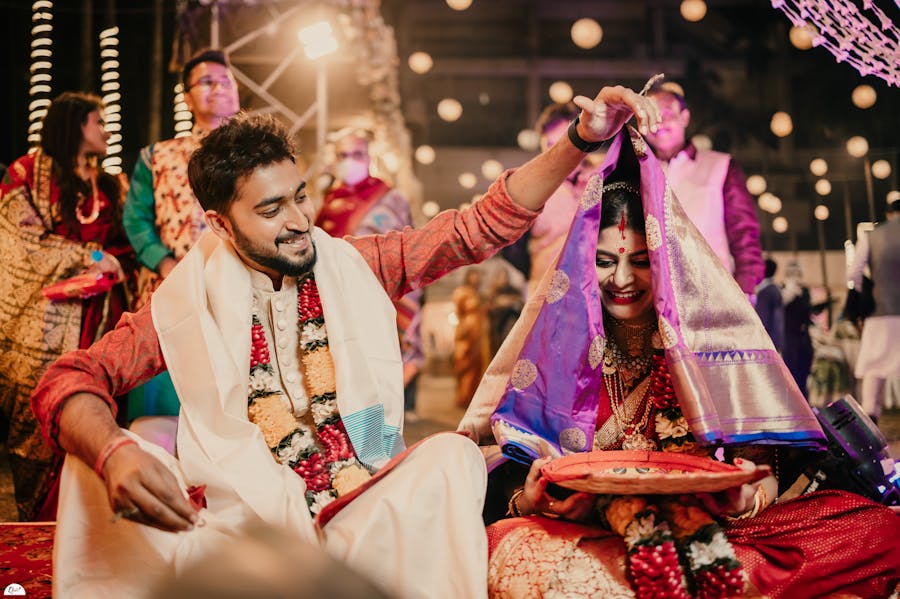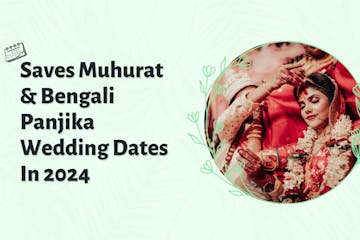Importance of Bengali Wedding Rituals & Traditions
Apart from Bengali’s obsession with football, fish, sweets, and Durga puja, a lesser-known one is Bengali Weddings and their rituals. It is needless to say that Bengali weddings are a treat to the eyes. From the decoration to the colorful garlands, to the food menu, Bengali Weddings are one of the most extravagant celebrations that one can witness. Believe it or not, being a part of a Bengali wedding is a lifetime experience.
A traditional Bengali wedding is certainly more than just a union of two souls. It is much more than one can imagine of any wedding ceremony and is especially characterized by extremely excited, enthusiastic friends and family members, happy faces flaunting their teeth all around, and wide smiles spreading good vibes. At the same time, a sad face of a mother may also be visible who is going to be parted from her daughter, but in the next moment, she could be seen dancing with other members of the family. All in all Bengali weddings really can be a treat to the eyes.
💡 Do you know: How to Live Stream your Wedding



Without any further ado let’s get familiar with the most popular Bengali wedding rituals that you need to know
These are a few of the most popular Bengali wedding rituals that you need to know. However, these rituals can be categorized into three different sections namely:-
- Pre-wedding rituals
- Wedding rituals
- Post-wedding rituals
Let us get into some more details of these rituals for you to know better.
1. Pre-wedding Rituals
- Adan Prodan:
The word ‘Adan prodan’ means give and take in English. A Bengali wedding starts off with this very ritual but here give and take don’t involve any kind of monetary elements. It is about the basic need of any marriage i.e., Acceptance.
Back in old days, both the families used to meet and fix a date and location for the marriage but nowadays it is mostly done over phone calls due to busy work life. - Ai Buro Bhaat:
The word ‘Ai buro’ means bachelor or bachelorette, and ‘bhat’ means Rice. So this ritual signifies the last meal of a bachelor's life. It is one of the most awaited rituals of Bengali marriages. A grand feast is prepared for the bride and groom by close relatives, family members, and friends. The food menu of the Ai buro bhat includes various mouth-watering veg and non-veg delicacies of Bengal. - Vriddhi:
In this Bengali wedding ritual, the senior people from both families perform a puja where they worship and seek blessings from the ancestors of both the families for the bride and the groom. - Dodhi Mangal:
This is a kick-start of all the rituals in the bride’s house. In this ritual, the bride is supposed to wear a white saree with red borders, which is very popular among Bengalis. She is given ‘Mishti doi’ (yogurt) and ‘khoi’ (puffed rice) to eat during sunrise. - Gaye Holud:
Looking fresh and glowing is a must for both the groom and bride on their big day. People these days often go to a parlor or spa to get a readymade glow but in Bengali weddings, they do it in a natural way with this ritual of ‘Gaye Holud’. Undoubtedly, Bengalis know how to use the wonder spice- ‘Turmeric’, known as Holud in Bengali, and hence this ritual. The turmeric paste is first touched by the groom and then sent to the bride's place to be applied to her. It is more than just a ritual where everyone shares laughter and love by applying the 'holud' on each other. - Jol showa:
After the ‘Gaye holud’ ritual, family members and relatives takes the bride and groom to the nearest pond or preferably to the Ganga river (if it is nearby) to get them a bath. The groom’s or bride’s mother carries a ‘kalsi’ (brass or copper pot) to bring back water home. This ritual is done to summon the goddess Ganga to bless the groom and bride.
These are a few rituals that are the most popular as the pre-wedding rituals. After the pre-wedding rituals pave in the real fun or the wedding. There is a hell of a lot of rituals in the wedding process that follows one by one.



2. Wedding Rituals
- The Bor Jatri:
‘Bor’ or the groom accompanies his friends and family or ‘Jatri’ to the bride’s place for the final wedding ceremony. The journey from the Groom’s place to the bride's is enjoyed a lot by all with pomp, music, dance and also firecrackers these days. - Bor Boron:
The Groom is welcomed by the bride’s family and relatives at the entrance. The ritual is mainly held by the female members where the bride’s mother welcomes him with a Borondala (A thali that consists of several holy elements). - Saat Pak:
In this Bengali wedding ritual, the bride is made to sit on a ‘piri’ (a wooden board), cover her face with beetle leaves, and is taken around the groom seven times by her brothers or other male members of the family. The ritual signifies that the groom and bride are bonded with each other for seven lifetimes. - Subho Drishti:
Apparently, the bride and groom are not allowed to see each other until the ‘subho drishti’ on the marriage day. This is supposed to be the first sight of each other on that very day. The bride removes the beetle leaves from her face and eye contact is established. - Mala Bodol:
In this ritual, the bride and the groom exchange their garlands three times. - Sampradan:
In this Bengali wedding ritual, finally, the bride’s hand is given to the groom’s hand under the ‘Chhadnatola’ in the 'mandap' by a male member of the family, mostly the bride’s father. - Yagna:
The yagna is performed to please the gods and goddesses to shower their blessing on the couple. It is done by chanting Vedic Mantras by the priest. - Saptapadi:
Followed by the Yagna, the saptapadi is the Bengali wedding ritual that is performed by the bride and groom where they take six rounds around the fire, which signifies the eternal bond of the two souls. - Sindoor Daan:
This is the final Bengali wedding ritual, where the groom puts ‘sindoor’ (vermillion) on the bride’s forehead without looking at her, and then the bride’s head is covered with a new saree called the ‘lojja boshtro’.
With the ritual of "Sindoor Daan", the wedding ceremony comes to an end but again, that’s not all. Now, let’s move on to the post-wedding rituals in a Bengali Wedding.




3. Post-wedding Rituals
- Bashi biye:
This ritual happens on the next day of the wedding when the bride and groom are still at the bride’s place. In this ritual, the groom again puts sindoor on the bride’s forehead. - Bidai:
On this day, all the elders of the family gather to shower their blessings on the couple and after that, there happens the final ritual at the bride’s place where the bride leaves her father’s home with the groom to start a new journey of her life. - Bou Boron:
This is the welcoming ritual for the bride in the groom’s house. In this Bengali wedding ritual, the bride is made to stand on a plate full of milk and dye (red), and then she is made to walk on a white piece of cloth with her stained feet. Apparently, the bride is the ‘Laxmi’ of the house and hence it is the ritual of welcoming her. - Bhat Kapor:
‘Bhat’ means the food here and ‘kapor’ means ‘cloth’. So in this ritual, the groom takes responsibility for the bride’s food and clothes for the rest of her life, in front of the groom’s family. - Bou Bhat:
The other name of this ritual is the reception. Nowadays, it is all changed and the ‘boubhat’ is celebrated with family, relatives, and friends to introduce the new bride to everyone. Previously, the bride used to cook special dishes for the entire family.


So, these were the few Bengali wedding rituals, which are the most popular. These days, all the rituals are not properly followed and are changed over time, but it doesn’t really matter at all. Bengali weddings are an aura of dramatic yet astounding celebration of love. One will never know this flavor unless tasted. If you are looking for a photographer in Kolkata for wedding then contact us.







